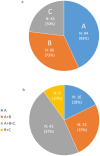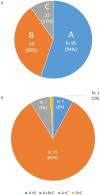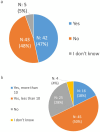A global survey about undiagnosed rare diseases: perspectives, challenges, and solutions
- PMID: 40078755
- PMCID: PMC11897027
- DOI: 10.3389/fpubh.2025.1510818
A global survey about undiagnosed rare diseases: perspectives, challenges, and solutions
Abstract
Background: Undiagnosed rare diseases (URDs) are a complex and multifaceted challenge, especially in low-and medium-income countries. They affect individuals with unique clinical features and lack a clear diagnostic label. Although the Undiagnosed Diseases Network International (UDNI) definition of URDs is not universally accepted, it is widely recognized.
Methods: We surveyed UDNI members and participants from other countries to explore the challenges posed by URDs and identify possible solutions. Participation in the survey was completely voluntary.
Results: The survey revealed a need for more consensus on a universally accepted definition for URDs. Still, the UDNI definition gained widespread recognition and serves as a valuable framework for understanding and addressing the challenges of URDs. In addition to national or international networks, fostering a more substantial engagement and resource-sharing ethos among member countries is critical. Despite advances in genomics and diagnostic tools, the diagnostic journey for people living with URDs (PLURDs) remains arduous and often inconclusive. The availability of specialized centers and the utilization of whole exome sequencing (WES) and whole genome sequencing (WGS) vary across countries, with disparities due to healthcare systems, economic status, and government policies. Advocacy groups play a crucial role in supporting PLURDs.
Conclusion: A unified commitment to prioritizing URDs on the global health agenda, paired with targeted funding, stipulated national strategies, and aligned international cooperation, is imperative to leveling the playing field for the diagnosis and management of URDs and capitalizing on the potential of Advocacy Groups as allies in this endeavor.
Keywords: advocacy groups; diagnostic journey; genomic diagnosis; healthcare disparities; people living with URDs (PLURDs); undiagnosed rare diseases (URDs).
Copyright © 2025 Baldovino, Sciascia, Carta, Salvatore, Cellai, Ferrari, Lumaka, Groft, Alanay, Azam, Baynam, Cederroth, la Paz, Dissanayake, Giugliani, Gonzaga-Jauregui, Hettiarachchi, Kvlividze, Landoure, Makay, Melegh, Ozbek, Pagava, Puri, Romero, Scaria, Jamuar, Shotelersuk, Roccatello, Gahl, Wiafe, Bodamer, Posada and Taruscio.
Conflict of interest statement
SW was employed by the Rare Disease Ghana Initiative. The remaining authors declare that the research was conducted in the absence of any commercial or financial relationships that could be construed as a potential conflict of interest. The author(s) declared that they were an editorial board member of Frontiers, at the time of submission. This had no impact on the peer review process and the final decision.
Figures




References
MeSH terms
LinkOut - more resources
Full Text Sources
Medical

